
Board members and stakeholders in downtown Beloit develop work plans that align with their five-year vision.
Looking forward to 2024, many organizations are thinking about their priorities for the new year.
If your organization has not completed a strategic plan in the past five years, it may be time to do so. A strategic plan is designed to make your organization more efficient, more responsive, and more coordinated in its work. The plan allows you to provide a clear picture of your organization’s vision for the community and call attention to tangible results of its efforts.
A focused strategic plan informs plans for fundraising, marketing, and work projects, making sure that each element of the Four Points approach—economic vitality, design, promotion, and organization—is directed toward a common goal. A strategic plan creates an opportunity to look ahead to the future rather than getting mired in the chaos of the day-to-day. Building an annual action plan that leads toward bigger future goals actually makes it easier for an organization to say no to requests that do not align with the vision and to encourage partners and funders to make long-term investments rather than focusing on one-time events or activities that may be unrelated to larger goals or to each other.
For organizations considering embarking on a new strategic plan, here are some tips to make the process as effective as possible.
Why plan?
First, consider what the organization hopes to achieve through strategic planning.
For an organization that is performing well and achieving its goals, a simple vision refresher and goal update might be all that is needed, while an organization with many new board or staff members might need a deeper dive into discussions of mission and impact. Decide what your organization wants to accomplish in the coming year and build this into the process. For instance, are you hoping to:
- Engage new audiences? Make sure to invite them to the table from the start.
- Get out of a rut? Host the session somewhere new, and make sure to include a variety of big picture and out-of-the-box visioning activities.
- Establish buy-in for a new direction? Highlight testimonials and impact figures from past initiatives in the background materials you share prior to the meeting, and be prepared to identify projects or tasks that can be let go in order to take on something new.
It’s also important to acknowledge that planning cannot solve every problem. If the organization lacks direction, board or staff lack accountability, or turnover is high, it would be better to focus on a few tangible steps that improve the organization’s function and reputation rather than embarking on new projects that are unlikely to be completed.
Preparing to plan
Once you’ve decided to undertake the planning process, make sure that you put in the advance work to create a foundation for success. Revisit past plans and identify which elements have been completed and which have fallen by the wayside, and why. Come prepared to the meeting with—or send to members in advance—critical information on the organization’s history, performance, budget, and staff and volunteer time allocation.
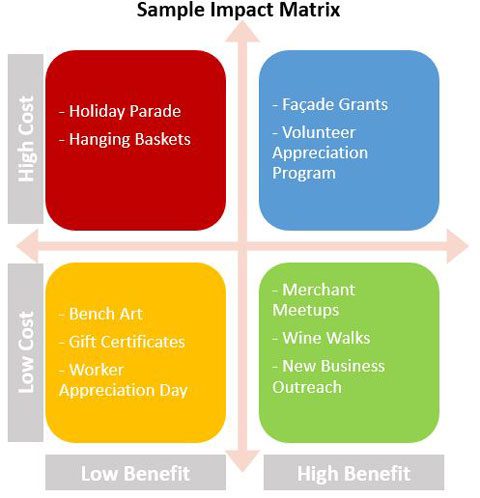
An impact matrix recognizes the relative cost (time and resources) versus impact of various initiatives.
If the organization serves specific communities or has a core group of major funders, it is also worthwhile to survey these individuals. Knowing how your partners perceive the organization, which activities or programs they find most valuable, and what opportunities they see in the future are important perspectives to have during the visioning process. Provide a summary of their comments to the group before the visioning session to ensure that outcomes align with expectations of key constituents. It’s important that all planning participants have a shared understanding of the organization’s mission, programs, and past achievements so that everyone will feel comfortable and confident in suggesting which projects to move forward.
Planning
There is no one set of planning exercises that is guaranteed to be successful. As long as ample opportunities exist for everyone to provide input in a variety of ways and encourage thoughtful discussion, the process is likely to produce substantive results.
You can conduct a strategic planning process internally under the guidance of your organization’s own leaders, but it is often helpful to engage a facilitator for the day. This allows everyone present to participate equally and provides a third-party perspective—someone who can ask critical questions and make observations that may not be apparent to the group. It is important that as many board members as possible attend the entire planning event. Those who do not attend may not have the same level of commitment to the new goals because they weren’t part of the process.
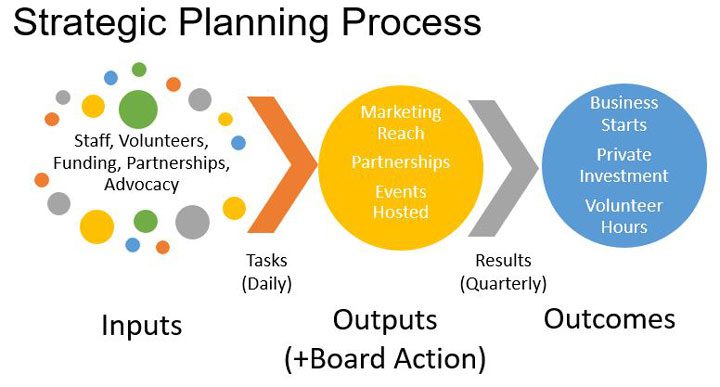
The planning process should connect organization resources (inputs) to their respective short-term activities (outputs) while retaining a focus on desired results (outcomes).
In addition to some of the basics such as SWOT analysis (examining strengths, weaknesses, opportunities, and threats) and Five Whys (repeatedly asking why to get to the root of a problem), here are some exercises that can assist with community development planning:
- Cost-benefit matrix: Make a list of all the programs and activities that your organization conducts in a typical year. Create a matrix with cost (including time, resources, and advocacy) on one axis and impact on the other. As a group, place each of the programs on the matrix, and make plans to improve or eliminate programs that are high cost and low impact.
- $1 million and 1,000 volunteers: To encourage participants to think big, ask them to brainstorm ways that they would spend a $1 million charitable gift that would have the biggest impact on your downtown district. Then, ask how they would leverage the talents of 1,000 volunteers in the coming year. Most communities have the ability to raise funds and recruit volunteers for worthy causes, but often don’t think big enough when it comes to pursuing those results. What could you achieve with nearly unlimited means?
- 20-year vision activity: Ask each participant to name three measurable things that would be different in 20 years if the organization is successful in achieving its vision. How would the organization function differently or be perceived differently? How would the district appear or function differently to someone walking down the street? The key to this exercise is to list a specific change, such as only half of the community’s businesses staying open on weekends, 25% increase in foot traffic, etc.) This activity can also be done within each element of the Main Street Four Points approach.
These two work plans focus on fundraising development efforts that will be necessary to achieve larger district goals. They include specific objectives that can be implemented in the short and medium terms to ensure long-term success.
WORK PLAN: BUILD A DONOR BASE
Primarily of individual donors
Objective 1: Seek efficient opportunities to collect contact information
Objective 2: Consider a “Friends of …” campaign
Objective 3: Continue to send an annual appeal
Objective 4: Add a “Give” button to the main navigation bar of your website
Objective 5: Offer a few donation receptacles at events
WORK PLAN: DOWNTOWN BUSINESS CONTRIBUTORS
Look to increase from 10% to 25% – 50%
Objective 1: Don’t pursue sponsorships less that $500
Objective 2: Bundle events
Objective 3: Add new sponsorships for programming
Objective 4: Consider a title sponsor at $5,000 – $10,000
Objective 5: Offer 3-year sponsorship commitments
Planning for success
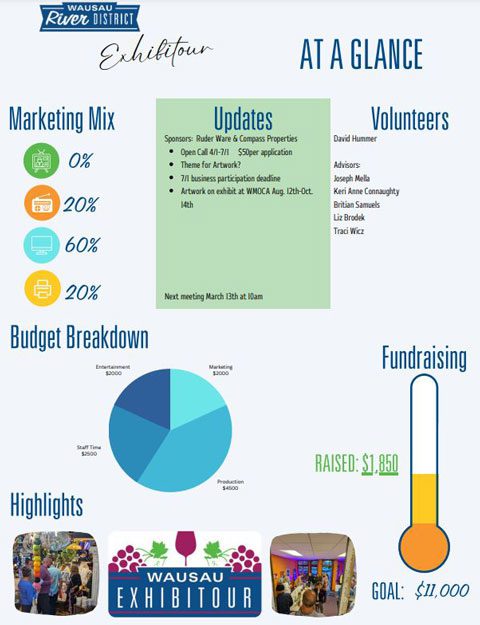
This program at-a-glance graphic lets board members clearly see how a planned event is performing and where additional resources may be needed.
Often the planning discussion ends and everyone goes home without defining how the plan will be integrated within current operations. For every project, program, or activity suggested, the board or committee responsible for the project should conduct a follow-up meeting to flesh out a work plan and determine budget implications. Each initiative, new or old, should have defined measures of success and a plan for tracking this information over time.
If a new initiative will need to generate public support or political capital to be successful, it needs to demonstrate consistent short-term wins. Ensure that the work plan includes some 60- or 90-day action items while building toward larger goals or fundraising for bigger items. An example might include a volunteer initiative to paint the aging doors of upper-floor apartments while developing a larger fund to update the building’s façade, or staging pop-up events in a vacant space while negotiating for future permanent improvements.
Consider the goals identified by the board. There are probably some initiatives the organization can take the lead on accomplishing, whereas others will require political capital or additional resources or skills. Looking at the list of goals, identify those that fall into the bucket for the organization to lead the way, those for which the organization will primarily advocate, and which ones need a partner to spearhead. Work plans can then reflect the next steps to take in light of the appropriate organizational role.
Finally, the organization should assess how it should allocate staff, volunteer time, and budget in light of the new plan. Some new initiatives may come with potential new sources of funding. For those that do not, funding will need to be shifted away from something the organization is already doing. Similarly, new activities almost always take more staff time to get off the ground than familiar ones. Existing activities may need to be shifted to a partner, downsized, reformatted, or ended altogether to make room for new and potentially more impactful activities. The cost-benefit matrix exercise should help identify where these cuts can be made.
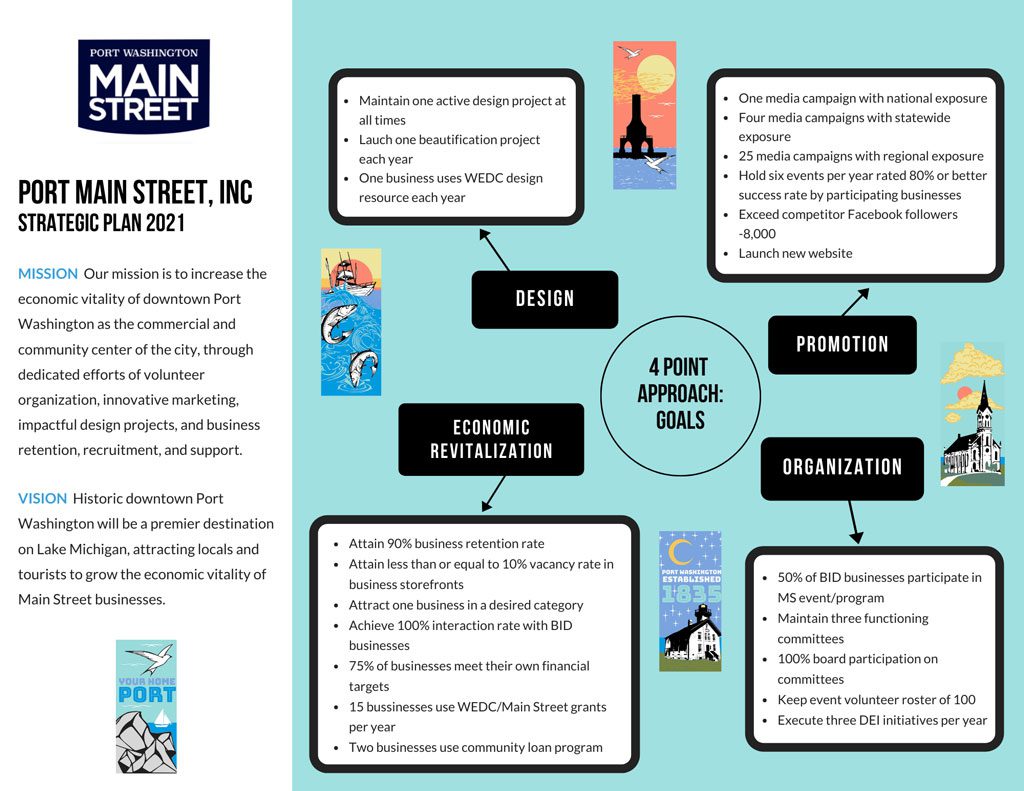
This visual illustration of the organization’s mission, vision, and goals clearly communicates the scope of work for the organization and the benefits it provides to the district.
Putting plans into action
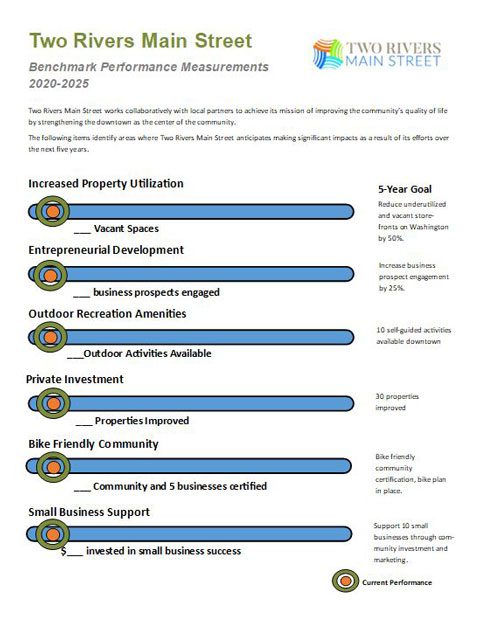
Clearly outlining the five-year goals for the organization and district, along with initiatives designed to advance these goals, helps organizations receive recognition for their contributions to the success of Main Street districts.
As you move forward with your new plan, make sure to keep your stakeholders informed. Share the input from stakeholders that supports your new vision or circulate testimonials from those who have taken advantage in the past of programs that will be expanding. Focus on highlighting success stories and opportunities to get involved, and be sure to tie individual projects to the greater vision for the district to keep the focus on the future rather than on things that may be missing or changing in the present. For stakeholders and funders, share your benchmark goals in an easy-to-read graphic that can be updated as your organization makes progress over time.
